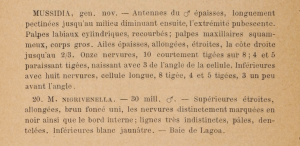3. Biologie
3.1. Nahrung der Raupe
- [Fabaceae:] Canavalia ensiformis (Jackbohne, Madagaskarbohne, Riesenbohne)
- [Fabaceae:] Mucuna pruriens (Samtbohne, Juckbohne)
- [Fabaceae:] Phaseolus lunatus (Limabohne)
- [Fabaceae:] Parkia biglobosa (Néré)
- [Malvaceae:] Gossypium hirsutum (Behaarte Baumwolle)
- [Malvaceae:] Theobroma cacao (Kakaobaum)
- [Malvaceae:] Adansonia digitata (Afrikanischer Affenbrotbaum, Afrikanischer Baobab)
- [Sapotaceae:] Butyrospermum parkii (Karitébaum, Sheanussbaum, Schibutterbaum, Schibaum, Afrikanischer Butterbaum)
- [Olacaceae:] Ximenia americana
- [Rubiaceae:] Gardenia sokotensis
- [Poaceae:] Zea mays (Mais)
Mais ist sicher nicht die ursprüngliche Raupennahrung dieses aus Afrika stammenden Zünslers, aber heute gilt er in Subsahara-Afrika vor allem als Schädling in Mais-Kulturen. Agboka et al. (2010) schreiben in ihrem Abstract: "In West Africa, the most damaging lepidopteran pest of maize ears is the pyralid Mussidia nigrivenella. Although it is mostly described as a field pest, it can be found feeding on maize stored for up to 4 months. A survey was conducted in Benin in 2006 to assess M. nigrivenella infestations in different maize storage systems in the Southern (SGS) and Northern Guinea Savanna (NGS). In SGS and NGS the percentage of infested stores decreased from 86.7% to 26.7% and from 51.4% to 14.3%, respectively, during the first 28 weeks of storage."
Die Raupe dürfte hochgradig polyphag sein und Mais gehört dabei noch zu den relativ wenig geeigneten Nahrungspflanzen für Mussidia nigrivenella. Sétamou et al. (2007) stellen in ihrem Abstract jedenfalls klar: "Life table studies of Mussidia nigrivenella Ragonot, a pest of maize in Benin, showed that host plant species had a significant effect on larval survival and developmental time. The maximum percentage of larvae surviving was recorded on jackbean, Canavalia ensiformis (36%) and lowest on maize (18%). Mean developmental time for larvae was longest on maize (19.8 days) and shortest on jackbean (17.2 days). The number of eggs laid was highest for females from larvae fed on jackbean (x– = 176), followed by velvetbean, Mucuna pruriens (x– = 143), and lowest for females where larvae had fed on maize (x–= 127). Longevity of ovipositing females was higher on jackbean (5.4 days) than of those from any other host plants. According to the growth index and life table statistics, jackbean was the most suitable host plant, followed by velvetbean, and maize, the least suitable."
Sétamou (1999: 2) fasste zusammen: "Mussidia nigrivenella is a highly polyphagous herbivore (Moyal 1988; Silvie, 1993; Sétamou, 1996). In addition to maize, the borer attacks a great variety of plants, including cotton (Gossypium hirsutum L.), cocoa (Theobroma cacao L.), lima bean (Phaseolus lunatus L.), jackbean (Canavalia enseiformis (L.) DC.), velvetbeans (Mucuna pruriens DC.), the néré-tree (Parkia biglobosa (Jacq.) Benth.), and the shea butter-tree (Butyrospermum parkii (G. Don) Kotschy) (Moyal, 1988; Silvie, 1993; Sétamou, 1996). Mature fruiting structures of its various host plants are attacked by the borer, and the feeding of larvae on the reproductive plant parts often result in damage influencing yield directly."
S. 65 ist zu lesen: "The objectives of our study were (i) to compare the spatial distribution indices of M. nigrivenella on maize, Zea mays L. (Poaceae), and on four wild host plants commonly found in West Africa, i.e., Gardenia sokotensis Hutch (Rubiaceae), Parkia biglobosa (Jacq.) Benth. (Mimosaceae), Adansonia digitata L. (Bombacaceae) and Ximenia americana L. (Olacaceae) (Sétamou et al., 1999c), and (ii) to determine the number of samples needed to precisely assess population densities of the borer on these host plants." Für uns hier ist nur wichtig - dass alle diese Pflanzen stärker genutzt werden.
4. Weitere Informationen
4.1. Faunistik
Agassiz et al. (2013: 112) führen die Art bei den "adventive species" und schreiben zu England: "On cocoa London docks, 1930 and Dungeness, Kent, 1994. Sub-saharan Africa. This complex is under review." Ein Ergebnis dieses Reviews kenne ich noch nicht. Zu erwähnen ist aber, dass Buhl et al. (2005) über den Erstnachweis eines offensichtlich eingeschleppten Exemplars von Mussidia nigrivenella Ragonot, 1888, in Dänemark berichtet hatten, den Buhl et al. (2007: 104) dann bezüglich der Bestimmung korrigieren mussten: Mussidia fiorii. Ob die Artbestimmung aus England also noch stimmt oder nicht, ist mir nicht klar.
M. nigrivenella wurde aus Mozambique beschrieben. Ragonot (1888: 10) nennt als locus typicus "Baie de Lagoa", die heutige Baia de Maputo. Die Art - oder besser der Artkomplex - wurde auch in Madagaskar und vielen weiteren Ländern in Subsahara-Afrika nachgewiesen. Sétamou (1999: 2) zeigt eine Verbreitungskarte, die sich bei Auflösung des Komplexes aber sicher anders darstellt.
(Autor: Erwin Rennwald)
4.2. Literatur
- Agassiz, D.J.L., Beavan, S.D. & R.J. Heckford (2013): Checklist of the Lepidoptera of the British Isles. - Royal Entomological Society. 206pp.
- Agboka, K., Schulthess, F., Tamò, M., Hell, K. & S. Vidal (2010): The importance of Mussidia nigrivenella Ragonot (Lepidoptera: Pyralidae) as a post-harvest pest in different storage structures in Benin. — Journal of Stored Products Research, 46 (2): 81-86. DOI 10.1016/j.jspr.2009.10.004. [Sekundärzitat nach dem Abstract auf [sciencedirect.com]]
- Buhl, O., Falck, P., Jørgensen, B., Karsholt, O., Larsen, K. & F. Vilhelmsen (2005): Fund af småsommerfugle fra Danmark i 2004 (Lepidoptera). — Entomologiske Meddelelser 73: 73-86. [PDF auf danbif.dk/formidlingsarkiv]
- Buhl, O., Falck, P., Karsholt, O., Larsen, K. & F. Vilhelmsen (2007): Fund af småsommerfugle fra Danmark i 2006 (Lepidoptera). Records of Microlepidoptera from Denmark in 2006 (Lepidoptera). — Entomologiske Meddelelser 75: 89-109. [PDF auf danbif.dk/formidlingsarkiv]
- Erstbeschreibung: Ragonot, E.-L. (1888): Nouveaux genres et espèces de Phycitidae & Galleriidae: 1-52. Paris (Imprimerie Grandremy et Henon). [Digitalisat auf archive.org]
- Sétamou, M. (1999): Ecology and pest status of Mussidia nigrivenella Ragonot (Lepidoptera: Pyralidae), a cob borer of maize in West Africa. — 131 S.; Dissertation im Fachbereich Gartenbau der Universität Hannover. [PDF auf edocs.tib.eu]
- Sétamou, M., Schulthess, F., Bosque-Pérez, N.A., Poehling, H-M. & C. Borgemeister (2007): Bionomics of Mussidia nigrivenella (Lepidoptera: Pyralidae) on three host plants. — Bulletin of Entomological Research, 89 (5): 465-471. DOI: https://doi.org/10.1017/S0007485399000607. [Sekundärzitat nach dem Abstract auf [cambridge.org]]




![Einzelnachweis in Großbritannien [verschleppte Einzeltiere 1930 und 1994]](/res/img/flag/gb.gif)


![Vorkommen in Mosambik [locus typicus: Baia de Maputo (als "Baie de Lagoa")]](/res/img/flag/mz.gif)




